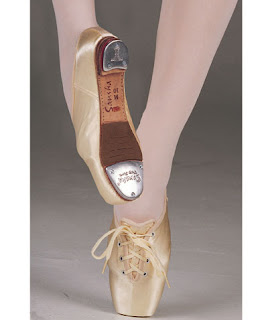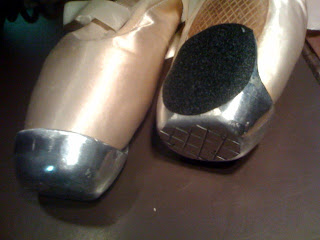Saturday, May 28, 2011
Arnica (Toetap foot cream)
This information comes from a great friend out in California . Who Has been Toetapping for the last twenty five years. When I asked her for some information on how to help people who toetap . Lessen there chances of foot problems. Before ,during and after a performance . She responded "get Arnica". I use it ! I had to do some toetap for two weeks strait . I rub it in before a performance and soak my socks in it after one . I never had feet issues when using it.
If it was good enough for her . I can pass on the information .
Arnica:
Medicinal usesArnica montana has been used medicinally for centuries.The roots contain derivatives of thymol, which are used as fungicides and preservatives. Arnica is currently used in liniment and ointment preparations used for strains, sprains, and bruises. Commercial arnica preparations are frequently used by professional athletes.
The thymol derivatives concentrated in the plants roots have been clinically shown to be effective vasodilators of subcutaneous blood capillaries. In one double-blind trial, Arnica montana was found to be equally effective as the more expensive diclofenac for accelerating wound healing after foot surgery, but was less effective than the same drug for pain relief. However, Diclofenac does not promote wound healing as it is an anti-inflammatory drug . A study of wound-healing after surgery to treat varicose veins found a trend towards a beneficial effect of reduction of pain and hematoma following surgery.
Overview:
Arnica (Arnica montana) has been used for medicinal purposes since the 1500s and remains popular today. Applied topically as a cream, ointment, liniment, salve, or tincture, Europeans and Native Americans have used arnica to soothe muscle aches, reduce inflammation, and heal wounds. It is often the first remedy used for injuries such as sprains and bruises. Arnica in herbal form is primarily restricted to topical (external) use because it can cause serious side effects when taken internally. Arnica is often used in homeopathy, and should be taken internally only in the extremely diluted form common to homeopathic remedies. If you have any question about whether you have the herbal or homeopathic form of arnica, talk to your doctor before taking it.
Plant Description:
Arnica is a perennial that grows to a height of 1 - 2 feet with yellow-orange flowers similar to daisies. Stems are round and hairy, ending in one to three flower stalks, with flowers 2 - 3 inches across. Leaves are bright green. The upper leaves are toothed and slightly hairy, while lower leaves have rounded tips. It is native to the mountains of Europe and Siberia, and is cultivated in North America.
Parts Used:
Fresh or dried flower heads are used in medicinal preparations.
Medicinal Uses and Indications:
•Arnica is used topically for a wide range of conditions, including bruises, sprains, muscle aches, wound healing, superficial phlebitis, rheumatic pain, inflammation from insect bites, and swelling due to fractures.
•Homeopathic preparations are also used to treat sore muscles, bruises, and other conditions caused by overexertion or trauma. Homeopathic doses are extremely diluted. They have no detectable amount of the plant in them and are generally considered safe for internal use when taken according to the directions on the product labeling.
Available Forms:
Arnica is available commercially in topical creams and ointments. It is most commonly prepared as a tincture, which can also be used as the base for compresses and poultices. Arnica oil may also be used in topical preparations.
A number of homeopathic remedies are available in pill, topical, or injectable forms.
How to Take It:
Arnica should not be taken internally without direct medical supervision, except in dilute form as a homeopathic remedy, because side effects may be severe (see "Precautions").
Homeopathic products should be used according to directions on the label or the advice of your homeopathic practitioner. Health care providers may give homeopathic preparations by injection.
When using arnica topically, never place on an open wound without a doctor's supervision.
Pediatric
Homeopathic preparations may be used to treat bruising, swelling, and trauma to soft tissues. Follow the dosage instructions on the product label or consult a licensed homeopath.
Adult
Topical preparations of arnica may be prepared as follows:
•Tincture: a 1:10 tincture prepared with 70% ethanol
•Creams and ointments: 20 - 25% tincture or a maximum of 15% arnica oil made from one part dried arnica flower head and five parts vegetable oil
•Compresses: tincture diluted 3 - 10 times with water
•Poultices: tincture diluted 3 - 10 times with water
•Mouthwash: tincture diluted 10 times with water (should not be swallowed)
Precautions:
Arnica is generally safe when used topically (externally). However, prolonged use may irritate the skin, causing eczema, peeling, blisters, or other skin conditions. Arnica should not be used on broken skin, such as leg ulcers. Also, people who are hypersensitive or allergic to the herb should avoid it.
Arnica is rarely used as an internal herbal remedy because it can cause dizziness, tremors, and heart irregularities. It may also irritate mucous membranes and cause vomiting. Large doses can even be fatal. Do not take arnica internally except under close supervision of your doctor. Homeopathic remedies, which use very small amounts of arnica, can usually be taken safely.
If you are pregnant or breast-feeding, talk to your doctor before taking any medication, including herbs.
Possible Interactions:
When used topically or in a homeopathic remedy, arnica does not interact with any conventional medications
Where to get it:
Manufacturer: NELSON HOMEOPATHICS
Description: Arnica Cream
Size: 50 gm
I belive this is the one she is speaking of . I will ask her to be sure and Post her answer .
If it was good enough for her . I can pass on the information .
Arnica:
Medicinal usesArnica montana has been used medicinally for centuries.The roots contain derivatives of thymol, which are used as fungicides and preservatives. Arnica is currently used in liniment and ointment preparations used for strains, sprains, and bruises. Commercial arnica preparations are frequently used by professional athletes.
The thymol derivatives concentrated in the plants roots have been clinically shown to be effective vasodilators of subcutaneous blood capillaries. In one double-blind trial, Arnica montana was found to be equally effective as the more expensive diclofenac for accelerating wound healing after foot surgery, but was less effective than the same drug for pain relief. However, Diclofenac does not promote wound healing as it is an anti-inflammatory drug . A study of wound-healing after surgery to treat varicose veins found a trend towards a beneficial effect of reduction of pain and hematoma following surgery.
Overview:
Arnica (Arnica montana) has been used for medicinal purposes since the 1500s and remains popular today. Applied topically as a cream, ointment, liniment, salve, or tincture, Europeans and Native Americans have used arnica to soothe muscle aches, reduce inflammation, and heal wounds. It is often the first remedy used for injuries such as sprains and bruises. Arnica in herbal form is primarily restricted to topical (external) use because it can cause serious side effects when taken internally. Arnica is often used in homeopathy, and should be taken internally only in the extremely diluted form common to homeopathic remedies. If you have any question about whether you have the herbal or homeopathic form of arnica, talk to your doctor before taking it.
Plant Description:
Arnica is a perennial that grows to a height of 1 - 2 feet with yellow-orange flowers similar to daisies. Stems are round and hairy, ending in one to three flower stalks, with flowers 2 - 3 inches across. Leaves are bright green. The upper leaves are toothed and slightly hairy, while lower leaves have rounded tips. It is native to the mountains of Europe and Siberia, and is cultivated in North America.
Parts Used:
Fresh or dried flower heads are used in medicinal preparations.
Medicinal Uses and Indications:
•Arnica is used topically for a wide range of conditions, including bruises, sprains, muscle aches, wound healing, superficial phlebitis, rheumatic pain, inflammation from insect bites, and swelling due to fractures.
•Homeopathic preparations are also used to treat sore muscles, bruises, and other conditions caused by overexertion or trauma. Homeopathic doses are extremely diluted. They have no detectable amount of the plant in them and are generally considered safe for internal use when taken according to the directions on the product labeling.
Available Forms:
Arnica is available commercially in topical creams and ointments. It is most commonly prepared as a tincture, which can also be used as the base for compresses and poultices. Arnica oil may also be used in topical preparations.
A number of homeopathic remedies are available in pill, topical, or injectable forms.
How to Take It:
Arnica should not be taken internally without direct medical supervision, except in dilute form as a homeopathic remedy, because side effects may be severe (see "Precautions").
Homeopathic products should be used according to directions on the label or the advice of your homeopathic practitioner. Health care providers may give homeopathic preparations by injection.
When using arnica topically, never place on an open wound without a doctor's supervision.
Pediatric
Homeopathic preparations may be used to treat bruising, swelling, and trauma to soft tissues. Follow the dosage instructions on the product label or consult a licensed homeopath.
Adult
Topical preparations of arnica may be prepared as follows:
•Tincture: a 1:10 tincture prepared with 70% ethanol
•Creams and ointments: 20 - 25% tincture or a maximum of 15% arnica oil made from one part dried arnica flower head and five parts vegetable oil
•Compresses: tincture diluted 3 - 10 times with water
•Poultices: tincture diluted 3 - 10 times with water
•Mouthwash: tincture diluted 10 times with water (should not be swallowed)
Precautions:
Arnica is generally safe when used topically (externally). However, prolonged use may irritate the skin, causing eczema, peeling, blisters, or other skin conditions. Arnica should not be used on broken skin, such as leg ulcers. Also, people who are hypersensitive or allergic to the herb should avoid it.
Arnica is rarely used as an internal herbal remedy because it can cause dizziness, tremors, and heart irregularities. It may also irritate mucous membranes and cause vomiting. Large doses can even be fatal. Do not take arnica internally except under close supervision of your doctor. Homeopathic remedies, which use very small amounts of arnica, can usually be taken safely.
If you are pregnant or breast-feeding, talk to your doctor before taking any medication, including herbs.
Possible Interactions:
When used topically or in a homeopathic remedy, arnica does not interact with any conventional medications
Where to get it:
Manufacturer: NELSON HOMEOPATHICS
Description: Arnica Cream
Size: 50 gm
I belive this is the one she is speaking of . I will ask her to be sure and Post her answer .







